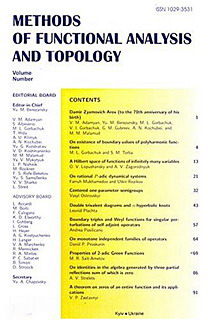V. M. Molyboga
orcid.org/0000-0002-5683-5694
Search this author in Google Scholar
Schrödinger operators with measure-valued potentials: semiboundedness and spectrum
Vladimir Mikhailets, Volodymyr Molyboga
MFAT 24 (2018), no. 3, 240-254
240-254
We study 1-D Schrödinger operators in the Hilbert space $L^{2}(\mathbb{R})$ a with real-valued Radon measure $q'(x)$, $q\in \mathrm{BV}_{loc}(\mathbb{R})$ as potentials. New sufficient conditions for minimal operators to be bounded below and selfadjoint are found. For such operators, a criterion for discreteness of the spectrum is proved, which generalizes Molchanov's, Brinck's, and the Albeverio-Kostenko-Malamud criteria. The quadratic forms corresponding to the investigated operators are described.
Spectral gaps of the Hill-Schrödinger operators with distributional potentials
Vladimir Mikhailets, Volodymyr Molyboga
MFAT 20 (2014), no. 4, 321-327
321-327
The paper studies the Hill-Schrödinger operators with potentials in the space $H^\omega \subset H^{-1}\left(\mathbb{T}, \mathbb{R}\right)$. The main results completely describe the sequences that arise as lengths of spectral gaps of these operators. The space $H^\omega$ coincides with the H\"{o}rmander space $H^{\omega}_2\left(\mathbb{T}, \mathbb{R}\right)$ with the weight function $\omega(\sqrt{1+\xi^{2}})$ if $\omega$ belongs to Avakumovich's class $\mathrm{OR}$. In particular, if the functions $\omega$ are power, then these spaces coincide with the Sobolev spaces. The functions $\omega$ may be nonmonotonic.
Remarks on Schrödinger operators with singular matrix potentials
Vladimir Mikhailets, Volodymyr Molyboga
MFAT 19 (2013), no. 2, 161-167
161-167
In this paper, an asymmetric generalization of the Glazman-Povzner-Wienholtz theorem is proved for one-dimensional Schrödinger operators with strongly singular matrix potentials from the space $H_{loc}^{-1}(\mathbb{R}, \mathbb{C}^{m\times m})$. This result is new in the scalar case as well.
Schrödinger operators with complex singular potentials
Vladimir Mikhailets, Volodymyr Molyboga
MFAT 19 (2013), no. 1, 16-28
16-28
We study one-dimensional Schrödinger operators $\mathrm{S}(q)$ on the space $L^{2}(\mathbb{R})$ with potentials $q$ being complex-valued generalized functions from the negative space $H_{{\operatorname{unif}}}^{-1}(\mathbb{R})$. Particularly the class $H_{{\operatorname{unif}}}^{-1}(\mathbb{R})$ contains periodic and almost periodic $H_{{\operatorname{loc}}}^{-1}(\mathbb{R})$-functions. We establish an equivalence of the various definitions of the operators $\mathrm{S}(q)$, investigate their approximation by operators with smooth potentials from the space $L_{{\operatorname{unif}}}^{1}(\mathbb{R})$ and prove that the spectrum of each operator $\mathrm{S}(q)$ lies within a certain parabola.
Hill's potentials in Hörmander spaces and their spectral gaps
V. A. Mikhailets, V. M. Molyboga
MFAT 17 (2011), no. 3, 235-243
235-243
The paper deals with the Hill-Schrödinger operators with singular periodic potentials in the space $H^{\omega}(\mathbb{T})\subset H^{-1}(\mathbb{T})$. The authors exactly describe the classes of sequences being the lengths of spectral gaps of these operators. The functions $\omega$ may be nonmonotonic. The space $H^{\omega}(\mathbb{T})$ coincides with the Hörmander space $H_{2}^{\omega}(\mathbb{T})$ with the weight function $\omega(\sqrt{1+\xi^{2}})$ if $\omega$ is in the Avakumovich class $\mathrm{OR}$.
Spectral gaps of one-dimensional Schrödinger operators with singular periodic potentials
Vladimir Mikhailets, Volodymyr Molyboga
MFAT 15 (2009), no. 1, 31-40
31-40
The behavior of the lengths of spectral gaps $\{\gamma_{n}(q)\}_{n=1}^{\infty}$ of the Hill-Schrödinger operators $$ S(q)u=-u''+q(x)u,\quad u\in \mathrm{Dom}\left(S(q) \right), $$ with real-valued 1-periodic distributional potentials $q(x)\in H_{1\mbox{-}{\operatorname{per}}}^{-1}(\mathbb{R})$ is studied. We show that they exhibit the same behavior as the Fourier coefficients $\{\widehat{q}(n)\}_{n=-\infty}^{\infty}$ of the potentials $q(x)$ with respect to the weighted sequence spaces $h^{s,\varphi}$, $s>-1$, $\varphi\in \mathrm{SV}$. The case $q(x)\in L_{1\mbox{-}{\operatorname{per}}}^{2}(\mathbb{R})$, $s\in \mathbb{Z}_{+}$, $\varphi\equiv 1$, corresponds to the Marchenko-Ostrovskii Theorem.
One-dimensional Schrödinger operators with singular periodic potentials
Vladimir Mikhailets, Volodymyr Molyboga
MFAT 14 (2008), no. 2, 184-200
184-200
We study the one-dimensional Schrödinger operators $$ S(q)u:=-u''+q(x)u,\quad u\in \mathrm{Dom}\left(S(q) \right), $$ with $1$-periodic real-valued singular potentials $q(x)\in H_{\operatorname{per}}^{-1}(\mathbb{R},\mathbb{R})$ on the Hilbert space $L_{2}\left(\mathbb{R} \right)$. We show equivalence of five basic definitions of the operators $S(q)$ and prove that they are self-adjoint. A new proof of continuity of the spectrum of the operators $S(q)$ is found. Endpoints of spectrum gaps are precisely described.
Uniform estimates for the semi-periodic eigenvalues of the singular differential operators
Volodymyr A. Mikhailets, Volodymyr M. Molyboga
MFAT 10 (2004), no. 4, 30-57
30-57
Singular eigenvalue problems on the circle
Volodymyr A. Mikhailets, Volodymyr M. Molyboga
MFAT 10 (2004), no. 3, 44-53
44-53
Estimates for periodic eigenvalues of the differential operator $(-1)^md^2m/dx^2m+V$ with $V$-distribution
MFAT 9 (2003), no. 2, 163-178
163-178

